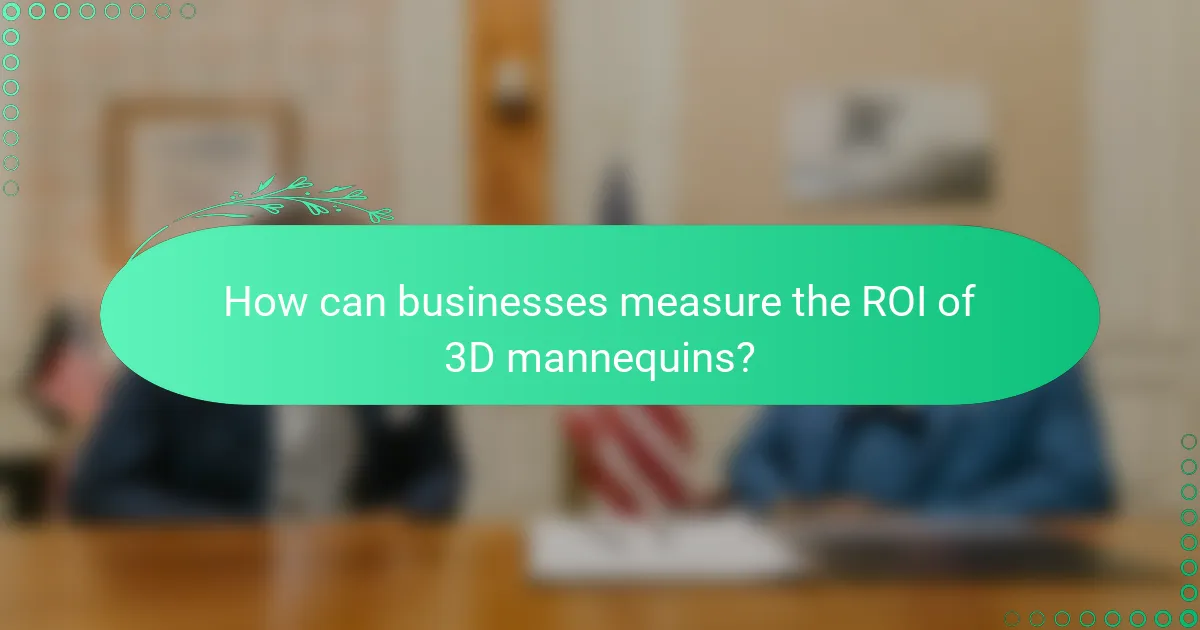3D mannequins are revolutionizing the retail landscape by providing enhanced customer interaction and improved product visualization, making them a valuable investment for businesses. With benefits such as cost efficiency, customization, and durability, these digital tools not only elevate marketing strategies but also help reduce long-term expenses. The investment in 3D mannequins varies widely, typically ranging from $500 for basic models to over $5,000 for advanced versions, influenced by features and software integration.

What are the benefits of 3D mannequins for retail businesses?
3D mannequins offer significant advantages for retail businesses by enhancing customer interaction, improving product visualization, and providing a cost-effective marketing solution. These digital tools can transform the shopping experience, making it more engaging and efficient.
Enhanced customer engagement
3D mannequins capture customer attention by providing an interactive experience that traditional displays cannot match. Shoppers can view products from multiple angles, which increases their interest and time spent in-store or on a website.
Retailers can integrate augmented reality features, allowing customers to virtually try on clothing or accessories. This interactive element not only boosts engagement but also encourages social sharing, further promoting the brand.
Improved product visualization
With 3D mannequins, retailers can showcase their products in a more realistic and appealing manner. This technology allows for detailed representations of items, helping customers visualize how products will look in real life.
For example, fashion retailers can create lifelike representations of outfits on 3D mannequins, highlighting fabric textures and fit. This clarity can lead to higher customer satisfaction and reduced return rates, as buyers have a better understanding of what they are purchasing.
Cost-effective marketing solution
Investing in 3D mannequins can be a cost-effective marketing strategy for retailers. While initial setup costs may vary, the long-term benefits often outweigh these expenses, especially when considering reduced physical inventory and display costs.
Additionally, 3D mannequins can be reused across various campaigns and platforms, minimizing the need for frequent updates. This flexibility allows businesses to adapt quickly to market trends without incurring significant costs.

How do 3D mannequins compare to traditional mannequins?
3D mannequins offer several advantages over traditional mannequins, including cost efficiency, customization, and durability. These digital models can significantly enhance marketing strategies while reducing long-term expenses.
Lower long-term costs
Investing in 3D mannequins can lead to lower long-term costs compared to traditional options. While the initial setup may be higher, the absence of physical materials and storage needs can result in savings over time.
For instance, businesses can avoid expenses related to shipping, maintenance, and replacement of physical mannequins. Additionally, 3D mannequins can be reused for various campaigns without the need for new purchases.
Greater customization options
3D mannequins provide extensive customization options that traditional mannequins cannot match. Retailers can easily modify digital models to showcase different clothing styles, colors, and sizes, allowing for tailored marketing strategies.
This flexibility enables brands to quickly adapt their displays to changing trends or seasonal promotions, enhancing customer engagement. For example, a single 3D mannequin can be altered to represent multiple outfits, reducing the need for multiple physical models.
Increased durability
Durability is a significant advantage of 3D mannequins over traditional ones. Physical mannequins can suffer from wear and tear, leading to frequent replacements, while digital mannequins remain intact as long as the software is maintained.
Moreover, 3D mannequins are not subject to damage from environmental factors such as humidity or lighting, which can affect traditional materials. This resilience makes them a more reliable choice for long-term use in retail environments.

What is the cost range for investing in 3D mannequins?
The cost range for investing in 3D mannequins typically spans from around $500 for basic models to over $5,000 for high-end versions. Factors such as features, customization, and software integration can significantly influence the final price.
Basic models start at $500
Basic 3D mannequins, which are suitable for simple displays and presentations, generally start at about $500. These models often offer essential features without advanced customization options, making them a cost-effective choice for small retailers or businesses just beginning to explore 3D technology.
When considering basic models, evaluate the specific needs of your business. For instance, if you require only basic body shapes and poses, these models can provide a solid foundation without straining your budget.
High-end models can exceed $5,000
High-end 3D mannequins can exceed $5,000, offering advanced features such as customizable appearances, dynamic poses, and integration with virtual fitting rooms. These models are ideal for larger retailers or brands that prioritize high-quality presentations and customer engagement.
Investing in high-end mannequins can yield significant returns through enhanced customer experiences and increased sales. However, ensure that the features align with your business goals to justify the higher investment.
Maintenance costs and software fees
In addition to the initial purchase price, consider ongoing maintenance costs and software fees associated with 3D mannequins. Regular updates and technical support may incur additional expenses, typically ranging from a few hundred to several thousand dollars annually, depending on the complexity of the system.
It’s crucial to factor these costs into your overall budget. Establish a clear understanding of the total cost of ownership, including potential upgrades and software subscriptions, to avoid unexpected financial burdens in the future.

What factors should be considered when choosing 3D mannequins?
When selecting 3D mannequins, consider factors such as target audience demographics, retail space dimensions, and integration with existing technology. Each of these elements plays a crucial role in ensuring that the mannequins effectively enhance customer engagement and sales.
Target audience demographics
Understanding your target audience demographics is essential when choosing 3D mannequins. Consider factors like age, gender, and lifestyle preferences, as these will influence the design and presentation of the mannequins. For instance, a fashion retailer targeting young adults may opt for trendy, dynamic poses, while a luxury brand might choose more elegant and sophisticated representations.
Additionally, consider cultural aspects that may affect how your audience perceives the mannequins. Tailoring the mannequins to resonate with local tastes can significantly improve customer connection and engagement.
Retail space dimensions
The dimensions of your retail space are critical when selecting 3D mannequins. Ensure that the size and scale of the mannequins fit well within the layout of your store, allowing for optimal visibility and customer interaction. For smaller spaces, consider using compact mannequins that can be easily positioned without overcrowding the area.
Moreover, think about how the mannequins will be arranged in relation to other displays and merchandise. A well-planned layout can enhance the shopping experience and encourage customers to explore more of your offerings.
Integration with existing technology
Choosing 3D mannequins that integrate seamlessly with your existing technology is vital for maximizing their effectiveness. If your store utilizes augmented reality (AR) or virtual fitting rooms, select mannequins that can be digitally manipulated or customized to reflect various styles and sizes. This integration can enhance customer engagement and provide a more interactive shopping experience.
Additionally, consider how the mannequins will work with your inventory management systems. Some advanced mannequins can be equipped with sensors to track customer interactions, providing valuable data on consumer behavior and preferences. This information can help refine marketing strategies and product placements.

How can businesses measure the ROI of 3D mannequins?
Businesses can measure the ROI of 3D mannequins by analyzing their impact on sales, customer engagement, and operational efficiency. Key metrics include sales performance, customer feedback, and foot traffic, which provide insights into how effectively these mannequins enhance the shopping experience and drive revenue.
Sales performance tracking
To evaluate sales performance, businesses should compare sales data before and after implementing 3D mannequins. Look for trends in revenue growth, average transaction value, and conversion rates. A common approach is to analyze sales over a few months to establish a baseline and then assess changes post-implementation.
Consider segmenting sales data by product category to identify which items benefit most from the 3D mannequins. For example, if clothing sales increase significantly for specific styles showcased by the mannequins, this indicates a positive ROI.
Customer feedback analysis
Gathering customer feedback is crucial for understanding the impact of 3D mannequins on shopper experience. Use surveys, comment cards, or digital feedback tools to collect insights on customer perceptions and preferences. Questions should focus on how the mannequins influence their shopping decisions and overall satisfaction.
Analyzing social media mentions and online reviews can also provide valuable information. Look for trends in customer comments regarding the visual appeal and engagement of the mannequins, which can help gauge their effectiveness in attracting and retaining customers.
Foot traffic measurement
Measuring foot traffic is essential to assess how 3D mannequins draw customers into the store. Utilize people counting technology or manual tracking methods to monitor changes in foot traffic before and after the mannequins are introduced. This data can help correlate increased visits with the presence of the mannequins.
Consider comparing foot traffic data during different times of the day or week to identify peak shopping periods. This analysis can inform staffing and marketing strategies, ensuring that resources are allocated effectively to maximize the benefits of the 3D mannequins.

What are the emerging trends in 3D mannequin technology?
Emerging trends in 3D mannequin technology include advancements in realism, customization, and integration with digital platforms. These innovations enhance the shopping experience and streamline inventory management for retailers.
Augmented reality integration
Augmented reality (AR) integration allows customers to visualize 3D mannequins in their own environments, enhancing engagement and decision-making. Retailers can use AR apps to let shoppers see how clothing looks on virtual mannequins in real-time, improving the online shopping experience.
To implement AR, businesses need to invest in software that supports 3D modeling and AR capabilities. This often involves collaborating with tech providers or using platforms that offer AR solutions. Consider the user experience; ensure that the AR interface is intuitive and accessible to a broad audience.
Common pitfalls include overcomplicating the AR experience or failing to optimize for mobile devices. Focus on simplicity and ensure that the AR feature enhances rather than distracts from the shopping experience. Testing with real users can provide valuable feedback before a full rollout.
